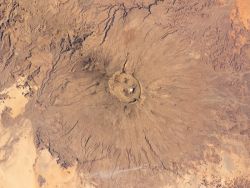![]()
A shield volcano takes its name from its shape, which looks like a warrior's shield seen from the side. It's much wider than it is high. Shield volcanoes are built up of a great many flows of runny lava, each of which is relatively thin, only a few meters (yards) thick. Characteristic features of shield volcanoes are lava tubes, underground channels that fed the flows on the slopes of the volcano.
Olympus Mons on Mars is the tallest volcano known, yet it is actually a gigantic shield volcano built from countless thin lava flows. The volcano on Earth that most resembles Olympus Mons is the entire Big Island of Hawaii. The Big Island is Earth's second largest shield volcano, built from five overlapping individual volcanoes. (The largest shield volcano on Earth is the Tamu Massif, on the floor of the Pacific Ocean; it lies wholly underwater.) Two of these — Mauna Loa and Kilauea — are active today. (Kilauea has been erupting continuously since 1983.)
Starting from the ocean floor and going to its highest point (the inactive summit of Mauna Kea), the Big Island rises about 10,000 meters (33,000 feet). That's impressive! But Olympus Mons is more than twice as high and nearly three times wider than the entire Big Island, including its underwater part. Mars also has smaller shields, called low shields, which are also seen on Earth. They usually have a central vent, occur in clusters, and are not seen in the Southern Highlands. The top of a shield volcano usually has a depressed area. Scientists call this a caldera.


